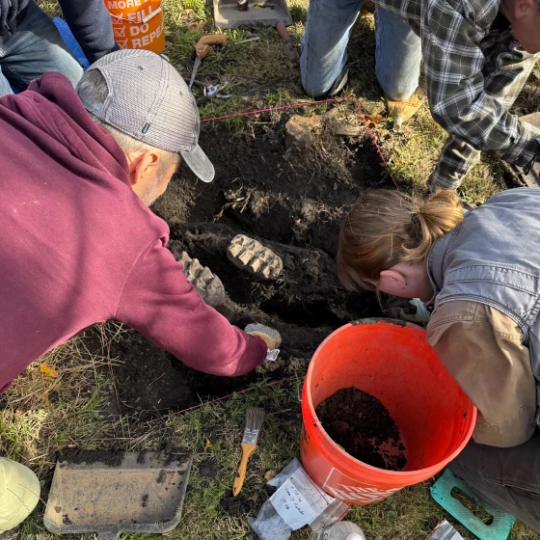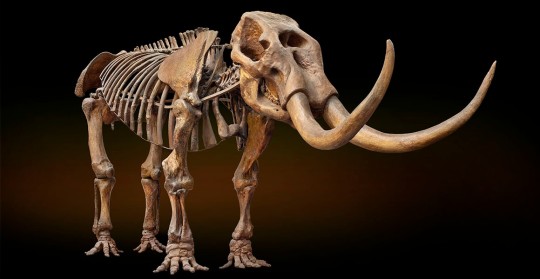#Complete Mastodon Jaw Fossil Found in New York
Explore tagged Tumblr posts
Text


Complete Mastodon Jaw Fossil Found in New York
The homeowner initially found two teeth hidden by a plant on the property, and after digging just a few inches underneath that, two more teeth were found.
A historic (or perhaps more accurately, prehistoric) discovery was made just under the surface of a New York homeowner’s lawn.
A complete mastodon jaw was found in the backyard of a home in the Orange County town of Scotchtown, according to state officials. The jaw, along with additional bone fragments, was recovered by researchers from the New York State Museum and SUNY Orange, the state Education Department said in a press release Tuesday.
It was the first find of its kind in New York in more than 11 years, the officials said.
The mastodon jaw, which was believed to be from an adult, was unearthed by researchers after the homeowner spotted it coming out from his lawn. The homeowner initially found two teeth hidden by a plant on the property, and after digging just a few inches underneath that, two more teeth were found.
“When I found the teeth and examined them in my hands, I knew they were something special and decided to call in the experts,” the homeowner said.
Staff from the museum and university led excavation efforts after that, and uncovered the well-preserved jaw of the mastodon — an ancient relative of modern elephants. A piece of a toe bone and a rib fragment were found as well, officials said.



“While the jaw is the star of the show, the additional toe and rib fragments offer valuable context and the potential for additional research,” said Dr. Cory Harris, Chair of SUNY Orange’s Behavioral Sciences Department. “We are also hoping to further explore the immediate area to see if there are any additional bones that were preserved.”
The fossils will undergo carbon dating and analysis in order to determine just how long ago the mammal was roaming the area, what the diet consisted of, and details of its habitat, according to officials, who noted that the discovery will be featured in public programming starting in 2025.
“This discovery is a testament to the rich paleontological history of New York and the ongoing efforts to understand its past,” said Dr. Robert Feranec, director of Research & Collections and curator of Ice Age Animals at the New York State Museum. “This mastodon jaw provides a unique opportunity to study the ecology of this magnificent species, which will enhance our understanding of the Ice Age ecosystems from this region.”
About 150 mastodon fossils have been found to date across New York, about a third of which found in Orange County.


#Complete Mastodon Jaw Fossil Found in New York#Scotchtown#mastodon#prehistoric#fossils#paleontologists#ancient artifacts#archeology#archeolgst#history#history news#ancient history
44 notes
·
View notes
Text
New York man digs up Mastodon fossil in his backyard
Some people want hippos for Christmas, but a man in Scotchtown, New York, got a mastodon. The man, who does not want to be identified, found a fossilized mastodon jaw, complete with the extinct giant’s distinctive teeth, in his backyard earlier this year. Scotchtown is about 70 miles (112 kilometers) northwest of New York City, and the jaw is the first found in the state in more than a decade. A…

View On WordPress
0 notes
Note
I’m a little behind on Mastodon lore. Can you tell me more stuff?
There’s quite a bit of history involving mastodons:
The American mastodon was first named Elephas americanum in 1792. The first mastodon fossil found was a giant tooth excavated by a New York farmer in 1705. As more bones were found across the then-colonies, it was first called an “incognitum”, and recognized as being similar to elephants. After being named, it was then moved to its own genus Mammut by Johann Blumenbach in 1799. Yep, the name refers to the mammoth - it was presumed the American finds were closely related to Siberian mammoths being excavated around the same time.
Fun fact 1: the word “mammoth” is derived from the obsolete Russian word мамант, which probably comes from the Mansi term mēmoŋt, meaning “earth horn”.
Fun fact 2: you can blame Thomas Jefferson for why “mammoth” is used to refer to very big things
The first complete mastodon skeleton (and the second complete fully-assembled fossil skeleton ever) was unveiled in 1806. Fun story behind that one; the first bones of it were discovered by a farmer named John Masten, who invited his friends over to help excavate. They ended up getting very drunk and accidentally destroyed some of the excavated fossils. Charles Wilson Peale heard about this and paid for the surviving fossils as well as the rights to excavate for more bones on Masten’s land. You may have seen this painting of the resulting excavation:

Fun fact 3: Peale thought it was a carnivore. And I quote: “Gracious God, what a jaw! How many animals must have been crushed beneath it!”
Fun fact 4: That first mounted specimen still stands. It’s in Germany now.
It wasn’t until 1817 that Georges Cuvier recognized mammoths and mastodons were separate lineages. He also used these fossil elephant bones to, for the first time, argue that yes, species do go extinct. Here’s a giant creature that looks like an elephant but isn’t, and it certainly isn’t alive today. It was kind of a big deal.
The genus name Mastodon was named by Cuvier in 1817, with the type species Ms. giganteus. It translates to “breast tooth”, because he apparently thought the most important thing about it was that its teeth looked like tiddies. Ms. giganteus has since been recognized as the same species as the earlier-named Mt. americanum. I can’t find the publication that sunk it, but as far as I can tell, Mastodon hasn’t been widely used as a genus name since the 1930′s. Despite this, “mastodon” has come to be used as the common name for the genus Mammut.
There are a couple other genera that have been sunk into Mammut. Missourium Koch 1840 and Leviathan Koch 1841 are two of them. They’re the same thing. Albert Koch was much in the same vein as P.T. Barnum, i.e. he was very into money and fraud. He ran “Dr. Koch’s” (I don’t believe that man’s ever been to medical school) Museum in St. Louis and charged people to see wax sculptures, dioramas, artifacts, live animals, taxidermy animals, and faked taxidermy animals. But he sought out fossils. He bought a bunch of large bones from a Missouri farmer and arranged them into a creature he called a “Missourium”, which he later renamed “Leviathan”, because people really liked the Bible at this time. It was much larger than the other mounted mastodon, because it was a composite of multiple individuals. He also oriented the tusks the wrong way, because he thought it looked more fearsome. He took it on tour and claimed a bunch of bullshit about it that contemporary academics repeatedly called him out for. Paleontologists hated him, but the gullible public loved him.

Fun fact 5: Koch is also the guy behind the infamous “Hydrarchos”, which was a composite of a bunch of Basilosaurus bones.

Fun fact 6: Later in his life, Koch sold his museum’s contents to other museums. The “Hydrarchos” bones were unfortunately destroyed in World War II, but the “Missourium” specimen still stands, now correctly arranged, at the London Natural History Museum.
Okay. Back to mastodon taxonomy. So last year, M. americanum was recognized as comprising of two different species. The Pacific mastodon was recognized as morphologically distinct from mastodons east of Idaho (which are still M. americanum), and was named M. pacificus.
There are numerous other species assigned to Mammut. M .cosoensis and M. nevadanus used to be considered Pliomastodon until that genus was sunk into Mammut in 1996. M. raki is…. a species of Mammut. M. furlongi might belong to Zygolophodon. Nobody can agree on whether M. borsoni belongs to Mammut or Zygolophodon. I found one Serbian publication that tanks the entire genus Zygolophodon into Mammut as a subgenus, but nobody else agrees with that. Ultimately, as the M. pacificus paper alludes to, revision is needed.
Fun fact 7: Researching this post was complicated by the existence of the metal band Mastodon. They’re not bad, though.
352 notes
·
View notes